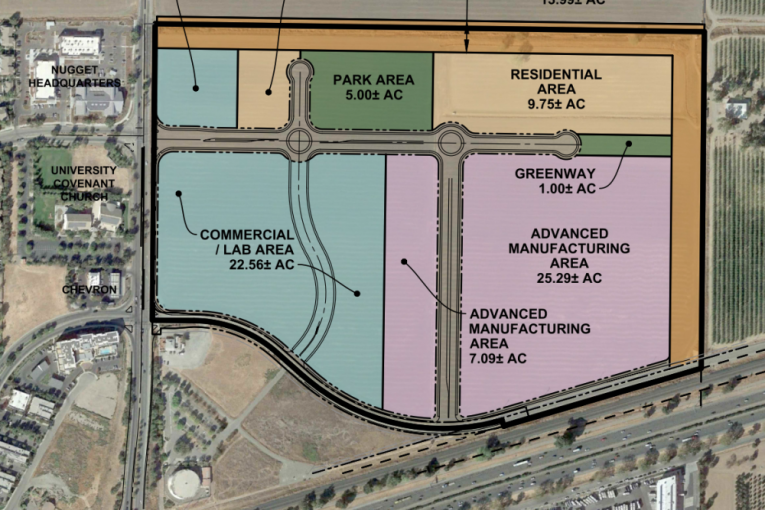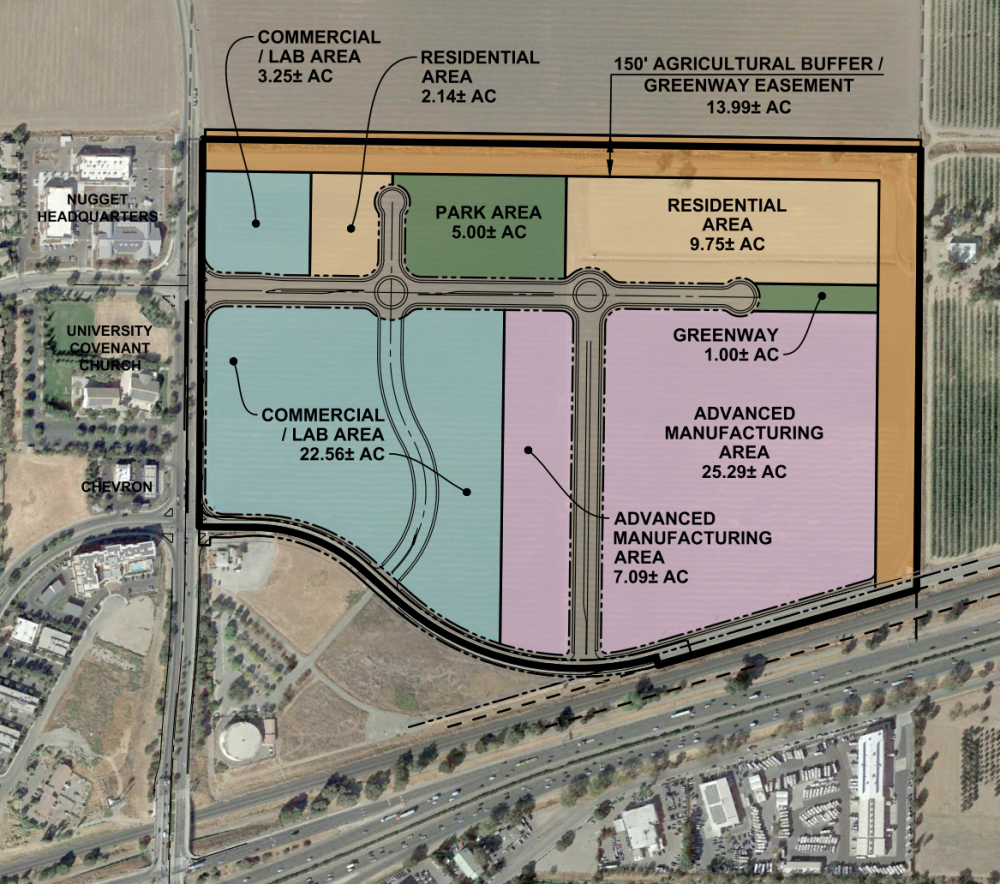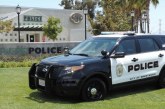

By David M. Greenwald
Executive Editor
Davis, CA – Yesterday I was told a bit about the story of the Research Triangle Park in North Carolina. At the time, leaders in North Carolina worried about the state’s economic future. Their per capita income was among the lowest in nation, one quip was they were 49th in the nation and thank goodness for Mississippi.
Leaders got together to take advantage of the Triangle’s three research universities: UNC-Chapel Hill, North Carolina State, and Duke University. Leaders decided to make the project a private endeavor, with cooperation from the universities, instead of being a government-sponsored action.
As an historical site notes, “Developers had to overcome a few problems.
“Leaders worked to rehabilitate the state’s image to attract companies (and their employees) from across the nation. One, the rest of the nation watched and read news reports detailing the Civil Rights Movement. Two, developers had to convince prospective companies that the South was capable of handling such a research park. Developers also needed to raise money and purchase land,” they write.
Research Triangle Park is now one of the top five research parks in the nation. It has fostered a boom of high-tech business and transformed the state.
As the Davis City Council weighs DiSC 2022, could DiSC have this kind of impact for Davis and the Sacramento Region?
Answer for me: not likely. DiSC is projected at 102 acres, which pales in size to the 7000-acre  RTP. But as we have seen with Aggie Square, even a relatively small park has the potential to attract high end companies and research.
RTP. But as we have seen with Aggie Square, even a relatively small park has the potential to attract high end companies and research.
Davis has the advantage of a world class university, in a region that has been developing its economic development base. Davis generates a huge amount of talent—most of which leaves the region after graduating. The university brings in $1 billion each year in research money—money and knowledge and technology that can be leveraged into technology transfer to the private sector.
The city of Davis has been described by many as a bedroom community, where many leave town to work in Sacramento. Many more still come into town to work at the university, which is by far the largest employer.
The city has become older, with much of its talent leaving for other areas of the country.
And yet in a lot of ways, the battle for DiSC, which will have to go to the voters in June for final approval, will likely not hinge on these issues. The people in Davis who vote, most of them are not tied to how many jobs are produced or even necessarily the cost of living in the area—the success or failure of this project will come down to impact mitigation rather than vision or economic promise.
The project has addressed most of what it can reasonably promise. They are now set to build a grade-separated crossing, they have put their commitments into the project baseline features, and have committed to a TDM to attempt to manage traffic.
Some have complained that because the project contains housing, it has morphed into a housing project. Others have argued that the number of employees will create new demands for housing in the city and the region.
At the end of the day, though, this project rises and falls based on the assessment of traffic impacts. While the southern portion of Mace Blvd. has gotten the most attention, with the derisive moniker, “Mace Mess,” problems with connectivity and added traffic on the northern section of Mace are troublesome to many who have seen long lines of traffic, particularly on Thursday and Friday evenings.
The new project decreases in size from over 200 acres to 102 acres and it reduces the projected traffic impact from 24,000 per day down to 11,000. But for many that remains troublesome—even with better traffic demand strategies, even with phasing the project over time, even with the promised upgrades to I-80 that are in the works by Cal Trans.
Will this cause the periodic traffic backups to increase in frequency and duration and in congestion? Or can the strategies put in place by the developers, along with fixes to Mace and upgrades to I-80, mitigate them?
This project holds out a lot of promise to improve the fiscal and jobs climate of Davis, but it might rise on fall depending on how well the developers can address issues like traffic impacts and the like.
Tonight likely will mark the first step in a four-month campaign that figures to be tightly fought over the future of the community. Stay tuned.







The project is going from zero to 102 and zero to 11,000, instead of zero to 200 and zero to 24,000. One does not go from a future that never was to a planned future that may be, one goes from now to the planned future that may be. Big difference.
A managed automobile lane. A bold new future. 😐
Where’s our promised Davis – W. Sac bike bridge, HUH? Makes headlines and then quietly disappears so no one knows it vanished.
Thank you, anything built or any new traffic is an addition, not a subtraction.
Well trained by Trackside proposal. Proposal wasn’t reduced from six to four stories as stated here many times. Site was first proposed to go from one to six stories (supposedly 😐 ), then proposed to go from one to four stories. Six to four same BS argument that evades the reality.
If this comes to a vote, I am not voting no because of traffic impacts, per se, but because it’s even less “Davis” (LD) in transportation than other peripheral areas of town.
It’s LD despite the offer of hard shuttles – albeit not operating on weekends or when people might be coming home after a movie or dinner after work – and soft promises, e.g. transportation demand management, which at best is a massage and some drugs that are entirely optional.
It’s LD because the developers have not committed to paid parking for commercial visitors, and are simply un-bundling residential parking.
It’s LD because developers LOVE the super-easy access to I-80 — and actually almost everyone does in relation to their personal use of transportation. Many people will work at home when there’s congestion, going in earlier or later than predicted congestion periods, thus gradually lengthening this period if there’s no other mitigation. Some will have to add to the congestion at its peak times. Few are going to take the shuttle or transit anywhere – with the latter using a dedicated transit lane which is in no way promised for the I-80 project, as there’s every indication that the new lane will be used for people in cars who can pay for it.
So LD means the supposed cycling and related culture of Davis and multiple specific goals related to climate change and transportation.
It will not positively-impacting traffic.
Positive doesn’t mean less traffic, but more good traffic. (Perhaps this is like good and bad cholesterol?). Due to the overwhelming bad influence of I-80, the likely unpaid parking, the utter lack of safe active transportation directly to South Davis and other factors, there’s no possibility of good traffic with DISC.
Good traffic would mean that everything at DISC would be folded into and distributed throughout Davis, in both grey- and some brownfields – i.e. on tops of parking lots, building up unnecessarily single-story commercial and light industrial areas, with both new structures and programs to connect these places, mostly well within the current borders of our City with an existing size and density that challenges alternatives for driving (except for children and people without cars).
Good traffic would come as a result of a new mixed-use development on top of 113 and next to UC Davis at its south end, which I have mentioned for years in this space, but detailed quite a bit more yesterday.
Good traffic would be the result of new development within a short distance of Davis Depot, and especially not requiring a doubling back for rail travel between Sac Valley Station, Davis Depot and DISC. How will DISC be more attractive than what’s at the Railyards when the latter is much closer to a train station – and everything else in a larger city?
The grade-separated crossing of Mace does not create good traffic. It connects directly only to one school – Harper – and it remains to be seen how many junior high kids will be living at DISC. The connections to Korematsu and Birch Lane use a variety of infrastructure, are not direct, or cross multiple egress points on a fast moving boulevard (East Covell). It’s unlikely that more than 5% of adults who have their own cars will travel to and from DISC by bicycle… or even bus. Per the UC Davis Campus Travel Survey for 2019/2020, a bit less than 10% of people with UC Davis destinations travel by bike to campus from a similar distance, and many of these people are student, likely with less cars and more wealth than most of the people who will live at and certainly visit DISC for work.
Good traffic does not come as a result of some consideration – or just an aside – about “bus rapid transit” mentioned – recently, I believe, for the first time – by developers.
Good traffic doesn’t come as a result of an owl condo, a riparian-ized drainage ditch, lots of trees, good jobs or buildings operating on 100% renewable energy. Many or all of these would be required in an infill version of DISC or similar by a new General Plan. A truly new General Plan would result in good development. Good development is required for good traffic. DISC is not good development.
The promised upgrades (which still has to secure local funding so it should properly be characterized as “hoped for” upgrades) will almost certainly induce additional traffic on I-80 negating any promised (“hoped for”) traffic congestion relief – see DISC Traffic Problems and Associated Vehicular Emissions Will not be Solved by the Proposed I-80 HOV Lane Expansion
David may be right, in that the traffic impacts are what’s most-important to voters. And they’ll probably be thinking of the cumulative impacts from the other proposals in the same area, as well – including Palomino Ranch, Shriner’s, future proposals on the “other half” of DISC, the area inside the Mace curve, etc. None of which are included in the traffic study for DiSC.
In a way, I view traffic impacts as “karma”, as a direct result of approving sprawling developments. Maybe part of the reason that I get perverse enjoyment out of seeing people stuck in it, as long as I’m not directly in it.
But the thing that bothers me most is the loss of highly-visible farmland and open space, jumping-beyond a logical boundary for the city. This is what really saddens me. I like the funkiness of Ikeda’s, while looking-out over farmland.
This proposal (and others) would end-up blocking-off views of farmland, further-breaking the connection between Davis and farmland, itself. Already, Davis itself does not have any real connection to its surrounding farmland. Most of the people living in Davis might as well be living in Manhattan, in regard to connections to farmland.
In addition, I don’t look forward to the inevitable increased roadway “infrastructure” (and the endless construction zone) associated with roadway “improvements”. But again, as long as I’m not in it, it’s “karma”. (The result sure would be uglier, though.)
On top of that, DiSC is nowhere near UCD. At least the “Davis Innovation Center” was a lot closer to UCD, before it failed and moved to Woodland (adding 1,600 homes in the process).
Years ago, I vaguely recall someone casually mentioning to me that the city might ultimately try to spread beyond Mace. I thought they were nuts, in regard to a town like Davis.
Not true. There’s the “Barn” at The Cannery. 😐
I urge the city council to move as many of the promises into the baseline features as possible, clarify some ambiguities about those promises (for example, see Colin Walsh’s comments about trees here:
https://www.davisvanguard.org/2022/02/letter-a-treeless-disc/)
and then move it forward onto the ballot for the voters to decide.
Individual council members may wish to state whether this reflects any endorsement or lack thereof on their parts. Their job, IMO, is to make the proposal as good as possible for the city’s residents, and then forward it to the voters per Measure J/R/D.
Your suggestion is good as to the JeRkeD measure… the key will be the final zoning entitlements, and the Tentative Map, perfected by any Final Maps/subdivision agreements… the latter is actually a contract, and provides for the up-front security for public improvements…
Bill,
How much development detail can be locked in during the annexation process outside of the Measure J vote? There’s some agreement between LAFCo and the city that exists. Is there anything (agreements/requirements) that goes beyond simply being in the city’s sphere of influence….can any agreements/requirements be part of the Municipal Services review for the sphere of influence?
In fact, now that I think about it, can’t a lot of the things that the public cares about like traffic requirements, alternative transportation (bicyles/buses..etc..) requirements, electrical availability/type/quality (ie. some degree of solar), rec space…. all be baked into the General Plan? And the General Plan can be extended into sphere of influence areas….basically setting up the requirements for future projects to be approved….at least I think that’s the way it’s supposed to work.